Input interpretation

1, 1, 1-trifluoroethane
Chemical names and formulas

formula | C_2H_3F_3 name | 1, 1, 1-trifluoroethane alternate names | 1, 1, 1-trifluoroform | ethane, 1, 1, 1-trifluoro- | Freon 143a | HFC-143a | methylfluoroform | R-143a mass fractions | C (carbon) 28.6% | F (fluorine) 67.8% | H (hydrogen) 3.6%
Lewis structure
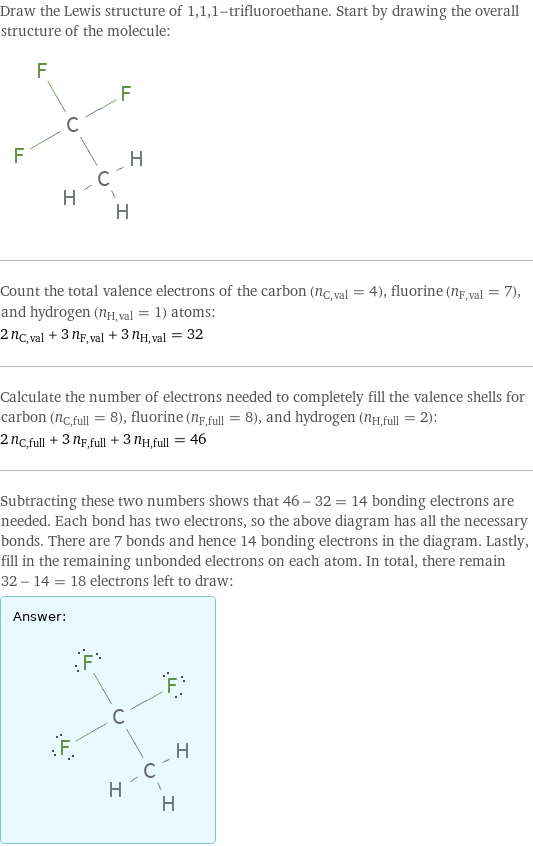
Draw the Lewis structure of 1, 1, 1-trifluoroethane. Start by drawing the overall structure of the molecule: Count the total valence electrons of the carbon (n_C, val = 4), fluorine (n_F, val = 7), and hydrogen (n_H, val = 1) atoms: 2 n_C, val + 3 n_F, val + 3 n_H, val = 32 Calculate the number of electrons needed to completely fill the valence shells for carbon (n_C, full = 8), fluorine (n_F, full = 8), and hydrogen (n_H, full = 2): 2 n_C, full + 3 n_F, full + 3 n_H, full = 46 Subtracting these two numbers shows that 46 - 32 = 14 bonding electrons are needed. Each bond has two electrons, so the above diagram has all the necessary bonds. There are 7 bonds and hence 14 bonding electrons in the diagram. Lastly, fill in the remaining unbonded electrons on each atom. In total, there remain 32 - 14 = 18 electrons left to draw: Answer: | |
3D structure

3D structure
Basic properties
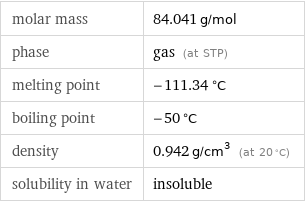
molar mass | 84.041 g/mol phase | gas (at STP) melting point | -111.34 °C boiling point | -50 °C density | 0.942 g/cm^3 (at 20 °C) solubility in water | insoluble
Units

Gas properties (at STP)
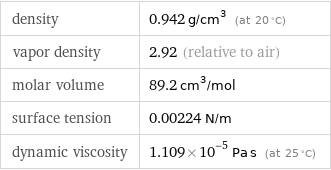
density | 0.942 g/cm^3 (at 20 °C) vapor density | 2.92 (relative to air) molar volume | 89.2 cm^3/mol surface tension | 0.00224 N/m dynamic viscosity | 1.109×10^-5 Pa s (at 25 °C)
Units

Thermodynamic properties
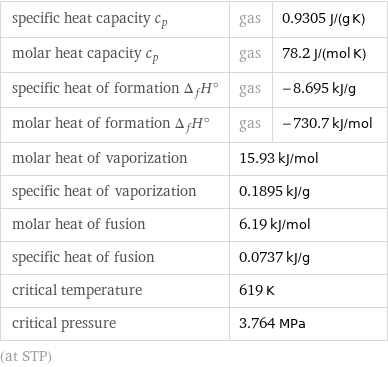
specific heat capacity c_p | gas | 0.9305 J/(g K) molar heat capacity c_p | gas | 78.2 J/(mol K) specific heat of formation Δ_fH° | gas | -8.695 kJ/g molar heat of formation Δ_fH° | gas | -730.7 kJ/mol molar heat of vaporization | 15.93 kJ/mol | specific heat of vaporization | 0.1895 kJ/g | molar heat of fusion | 6.19 kJ/mol | specific heat of fusion | 0.0737 kJ/g | critical temperature | 619 K | critical pressure | 3.764 MPa | (at STP)
Phase diagram
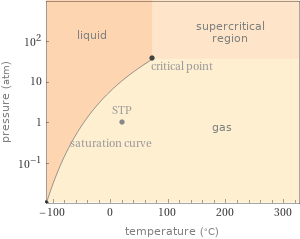
Phase diagram
Units

Chemical identifiers
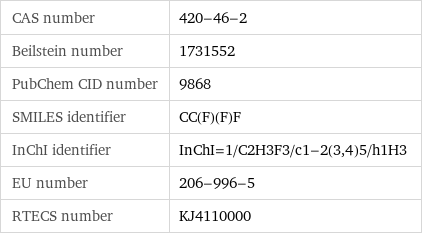
CAS number | 420-46-2 Beilstein number | 1731552 PubChem CID number | 9868 SMILES identifier | CC(F)(F)F InChI identifier | InChI=1/C2H3F3/c1-2(3, 4)5/h1H3 EU number | 206-996-5 RTECS number | KJ4110000
Safety properties

upper explosive limit | 20.5% (concentration in air)

DOT hazard class | 2.1 DOT numbers | 2035
Toxicity properties

RTECS classes | mutagen | reproductive effector